Valdemar Psilander (1884-1917) was the most popular star of the Danish cinema of the 1910s. Psilander took the German, Russian and Hungarian audiences by storm. At Nordisk he would play in six years 83 films.
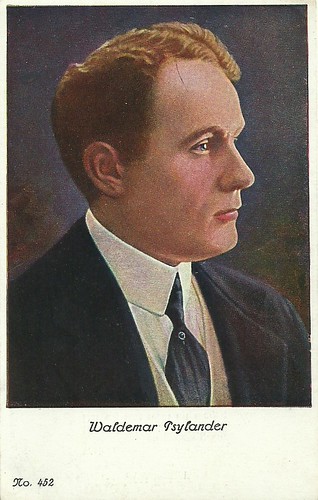
German postcard by MMB, no. 452. Photo: F.J. Wesselsky. The card has on the back Dutch publicity for J. Bijloos, Eau de Cologne.
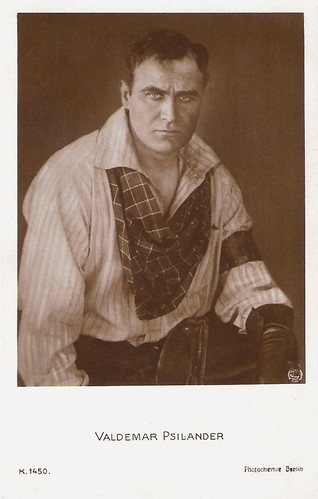
German postcard by Photochemie, Berlin, no. K. 1450. Photo: Nordisk. Publicity still for Manden uden Fremtid/The man without a future (Holger-Madsen, 1916).
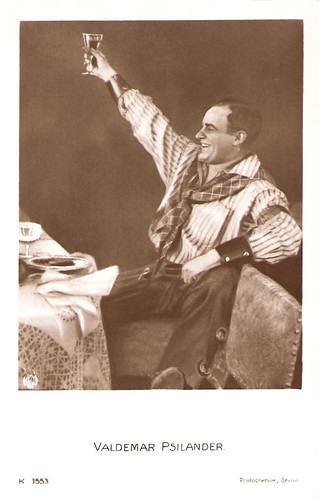
German postcard by Photochemie, Berlin, no. K. 1553. Photo: Nordisk. Publicity still for Manden uden Fremtid/The man without a future (Holger-Madsen, 1916). The German title was Prinz im Exil.
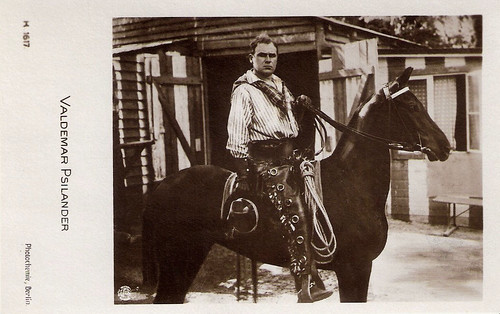
German postcard by Photochemie, Berlin, no. K. 1617. Photo: Nordisk. Publicity still for Manden uden Fremtid/The man without a future (Holger-Madsen, 1916).
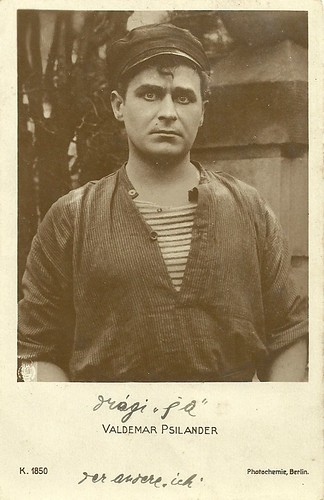
German postcard by Photochemie Berlin, no. K. 1850. Photo: Nordisk. Still for Das zweite Ich/Lykken/The Road to Happiness (Holger-Madsen, 1918).
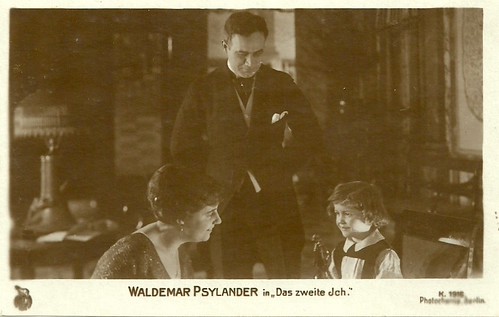
German postcard by Photochemie Berlin, no. K. 1916. Still for Das zweite Ich/Lykken/The Road to Happiness (Holger-Madsen, 1918) with Ebba Thomsen.

German postcard by Photochemie Berlin, no. K. 1921. Photo: Nordisk. Still
for Das zweite Ich/Lykken/The Road to Happiness (Holger-Madsen, 1918).
Valdemar Psilander was born in Copenhagen, Denmark in 1884. His family originated from Greece (one of his ancestors was named Psilandros), and later lived in Sweden.
Already at the age of 16, he played small parts on stage. Eventually he got leads as a stage actor, but in 1910 he decided to finish his stage career and move over to the burgeoning cinema.
Psilander debuted in the fall of 1910 for the small company Regia Art Film, with the title role in the Oscar Wilde adaptation Dorian Grays Portræt/The Portrait of Dorian Gray (Axel Strøm, 1910) with Clara Wieth (credited as Clara Pontoppidan) co-starring.
Shortly thereafter he was engaged by Nordisk Film. There he rose to stardom thanks to his role in the successful film Ved faenglets port/The Temptations of the Big City (August Blom, 1911) again opposite Clara Wieth. It was his first production at Nordisk, and he became the company's highest paid actor.
In spite of his imposing size and posture, we see him often vulnerable in this film: kneeling to mothers and girlfriends, begging for mercy for his behaviour. Striking is his habit of looking directly towards the spectator, as if he is begging the spectator as well.
Psilander took the German, Russian and Hungarian audiences by storm. The next six years, he would play in 83 films for Nordisk. Even when the film had a mediocre screenplay, it was - at least in the public's eyes - an attraction simply because of the charismatic star.

Danish postcard. Photo: Nordisk.
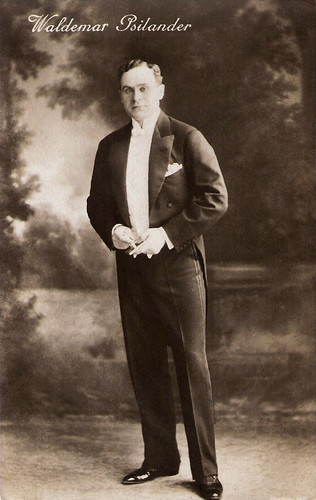
German postcard by Photochemie, Berlin.
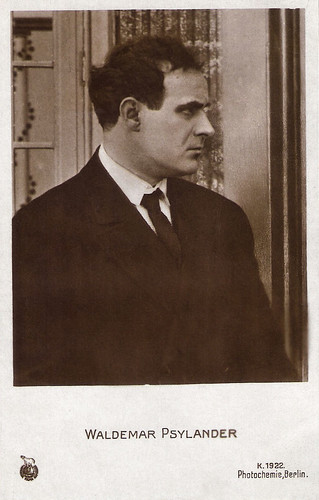
German postcard by Photochemie, Berlin, no. K. 1922. Photo: Nordisk.
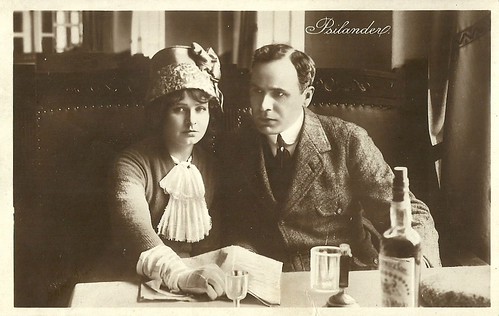
Austrian postcard by BKWI, no. 2. Photo: Projektograph Aktiengesellschaft, Vienna, distributor of Nordisk Films Co., Copenhagen. Valdemar Psilander and Ellen Aggerholm in Højt Spil/A dash for liberty (August Blom, 1913).

Austrian postcard by BKWI, no. 3. Photo: Projektograph Aktiengesellschaft, Vienna, distributor of Nordisk Films Co, Copenhagen. Publicity still for Gæstespillet/One Life, One Love (Eduard Schnedler-Sørensen, 1913) with Else Fröhlich.
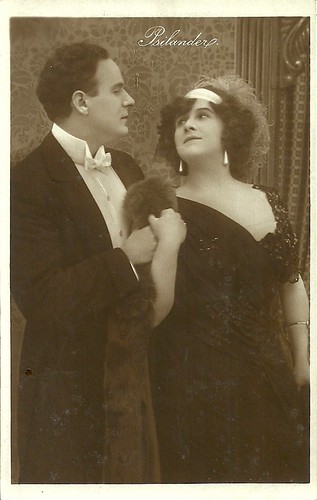
Austrian postcard by Postkartenverlag Brüder Kohn, Vienna, 1916. Publicity still for Gæstespillet/One Life, One Love (Eduard Schnedler-Sørensen, 1913) with Else Fröhlich.

German postcard by Photochemie. no. K. 1851. Photo: Nordisk Films.
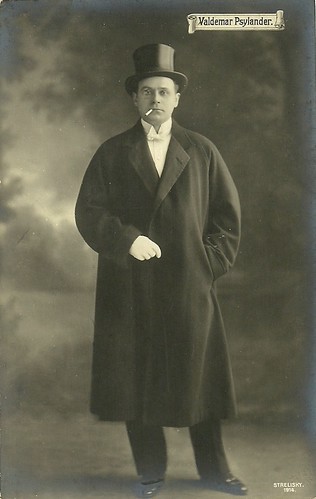
Hungarian postcard by Rubens, Budapest. Photo: Strelisky, 1914. Hungarion caption on the back of the card reads 'The world famous star at the Royal Orfeum in Budapest.'
In the same year, 1911, Valdemar Psilander played opposite the new female star of the Danish cinema, Asta Nielsen, in Den sorte drom/The Black Dream, (Urban Gad, 1911). Director Urban Gad had also directed Nielsen in her film debut Afgrunden/Abyss, (Urban Gad, 1910), and he would soon marry his diva.
In Den sorte drom Psilander again showed his character's vulnerability, this time using humour (clumsy mistakes). Asta Nielsen made another film with Psilander, Balletdanserinden/Ballet Dancer (August Blom, 1911), and then left with Gad for Berlin. She would have a prolific career there.
Valdemar Psilander remained in Denmark and continued to appear in such films as Et drama paa havet/The Great Ocean Disaster (Eduard Schnedler-Sørensen, 1912), Den sorte Kansler/The Black Chancellor (August Blom, 1912), Evangeliemandens Liv/A Preacher's Life (Holger-Madsen, 1915), Pro Patria (August Blom, 1916), and Klovnen/The Clown (A.W. Sandberg, 1917).
Before and during the First World War, the Danish company Nordisk gained enormously - thanks to Psilander's success. Psilander earned 100.000 Danish crowns in 1915. In comparison, his colleague Olaf Fönss only gained 14.000 crowns that year.
In 1916 Nordisk however refused him when he called for a raise to 250.000 Danish crowns, so he quitted at the end of 1916. Psilander founded his own production company Psilander-Film. But before it had really started, he suddenly died.
Only 32 years old, Valdemar Psilander passed away in 1917. At the peak of his career. Some say he died of a cardiac affliction, others say it was suicide.
Valdemar Psilander had been married to actress Edith Buemann. She afterwards said that he had been on drugs and was warned by doctors not to combine this with alcohol. Yet another version, more apt to his film roles, was that a Russian rival in love had come from St. Petersburg to shoot him.
After Valdemar Psilander's death, Nordisk still had so many of his films on the shelves that they continued to release new films with him until 1920.

German postcard by Photochemie, Berlin, no. K. 1852. Photo: Nordisk. Publicity still for Klovnen/The Clown (A.W. Sandberg, 1917).
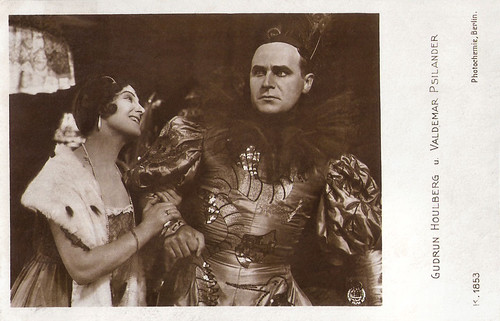
German postcard by Photochemie, Berlin, no. K. 1853. Photo: Nordisk. Valdemar Psilander and Gudrun Houlberg in Klovnen/The Clown (A.W. Sandberg, 1917).
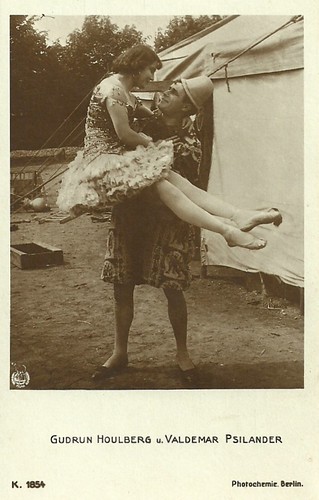
German postcard by Photochemie, Berlin, no. K. 1854. Photo: Nordisk. Valdemar Psilander and Gudrun Houlberg in Klovnen/The Clown (A.W. Sandberg, 1917).
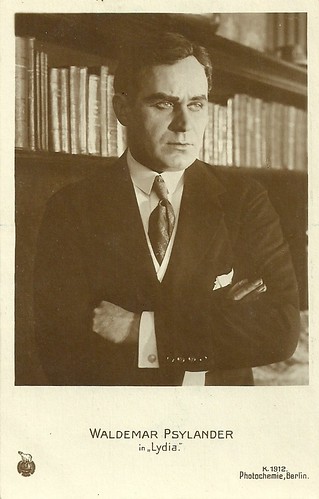
German postcard by Photochemie, Berlin, no. K. 1912. Photo: Nordisk Films. Valdemar Psilander in Lydia (Holger Madsen, 1918).
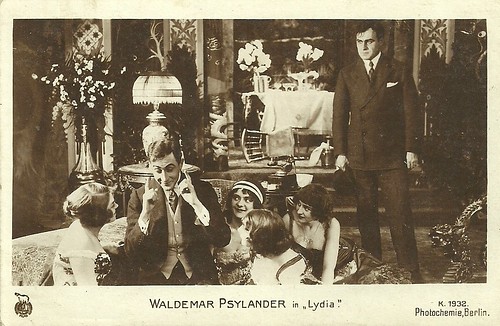
German postcard by Photochemie, Berlin, no. K. 1932. Photo: Nordisk Films. Valdemar Psilander in Lydia (Holger-Madsen, 1918).
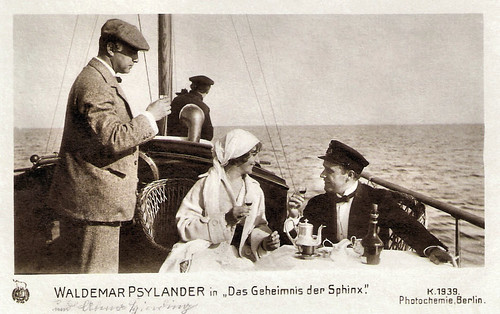
German postcard by Photochemie, Berlin, no. K. 1939. Photo: Nordisk Films. Alma Hinding and Valdemar Psilander in Das geheimnis des Sphinx, German release title for the Danish silent film Sfinxens Hemmelighed/The Secret of the Sphinx (Robert Dinesen, 1918).

German postcard by Photochemie, Berlin, no. K. 1930. Photo: Nordisk. Valdemar Psilander and Else Fröhlich in Rytterstatuen/For the king's statue (A.W. Sandberg, 1919). Its German release title was Um das Bild des Königs.
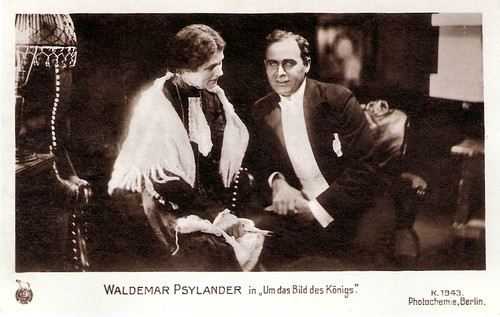
German postcard by Photochemie, Berlin, no. K. 1943. Photo: Nordisk. Valdemar Psilander in Rytterstatuen (A.W. Sandberg, 1919). Its German release title was Um das Bild des Königs (For the king's statue). The woman left of him is probably Augusta Blad, who played the mother of Psilander's character.
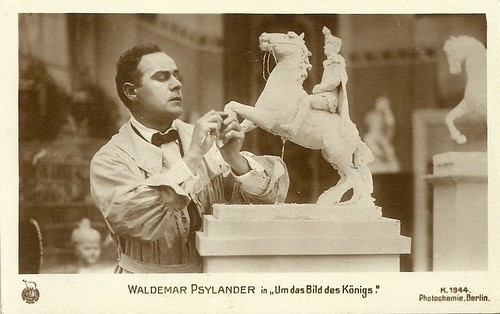
German postcard by Photochemie, Berlin, no. K. 1944. Photo: Nordisk. Valdemar Psilander in Rytterstatuen/For the king's statue (A.W. Sandberg, 1919).

German postcard by Photochemie, Berlin, no. K. 1945. Photo: Nordisk Films. Valdemar Psilander in Hans store Chance/Jernaktierne/His Big Breakthrough (Hjalmar Davidsen, 1919), released in Germany as Panik. The actress left might be Johanne Blom Fritz-Petersen.
Sources: Det Danske Filminstitut (Danish), Schiave bianche allo specchio. Le origini del cinema in Scandinavia 1896-1918, Thomas Staedeli (Cyranos), and IMDb.

German postcard by MMB, no. 452. Photo: F.J. Wesselsky. The card has on the back Dutch publicity for J. Bijloos, Eau de Cologne.

German postcard by Photochemie, Berlin, no. K. 1450. Photo: Nordisk. Publicity still for Manden uden Fremtid/The man without a future (Holger-Madsen, 1916).

German postcard by Photochemie, Berlin, no. K. 1553. Photo: Nordisk. Publicity still for Manden uden Fremtid/The man without a future (Holger-Madsen, 1916). The German title was Prinz im Exil.

German postcard by Photochemie, Berlin, no. K. 1617. Photo: Nordisk. Publicity still for Manden uden Fremtid/The man without a future (Holger-Madsen, 1916).

German postcard by Photochemie Berlin, no. K. 1850. Photo: Nordisk. Still for Das zweite Ich/Lykken/The Road to Happiness (Holger-Madsen, 1918).

German postcard by Photochemie Berlin, no. K. 1916. Still for Das zweite Ich/Lykken/The Road to Happiness (Holger-Madsen, 1918) with Ebba Thomsen.
German postcard by Photochemie Berlin, no. K. 1921. Photo: Nordisk. Still
for Das zweite Ich/Lykken/The Road to Happiness (Holger-Madsen, 1918).
Kneeling and Begging
Valdemar Psilander was born in Copenhagen, Denmark in 1884. His family originated from Greece (one of his ancestors was named Psilandros), and later lived in Sweden.
Already at the age of 16, he played small parts on stage. Eventually he got leads as a stage actor, but in 1910 he decided to finish his stage career and move over to the burgeoning cinema.
Psilander debuted in the fall of 1910 for the small company Regia Art Film, with the title role in the Oscar Wilde adaptation Dorian Grays Portræt/The Portrait of Dorian Gray (Axel Strøm, 1910) with Clara Wieth (credited as Clara Pontoppidan) co-starring.
Shortly thereafter he was engaged by Nordisk Film. There he rose to stardom thanks to his role in the successful film Ved faenglets port/The Temptations of the Big City (August Blom, 1911) again opposite Clara Wieth. It was his first production at Nordisk, and he became the company's highest paid actor.
In spite of his imposing size and posture, we see him often vulnerable in this film: kneeling to mothers and girlfriends, begging for mercy for his behaviour. Striking is his habit of looking directly towards the spectator, as if he is begging the spectator as well.
Psilander took the German, Russian and Hungarian audiences by storm. The next six years, he would play in 83 films for Nordisk. Even when the film had a mediocre screenplay, it was - at least in the public's eyes - an attraction simply because of the charismatic star.
Danish postcard. Photo: Nordisk.

German postcard by Photochemie, Berlin.

German postcard by Photochemie, Berlin, no. K. 1922. Photo: Nordisk.

Austrian postcard by BKWI, no. 2. Photo: Projektograph Aktiengesellschaft, Vienna, distributor of Nordisk Films Co., Copenhagen. Valdemar Psilander and Ellen Aggerholm in Højt Spil/A dash for liberty (August Blom, 1913).

Austrian postcard by BKWI, no. 3. Photo: Projektograph Aktiengesellschaft, Vienna, distributor of Nordisk Films Co, Copenhagen. Publicity still for Gæstespillet/One Life, One Love (Eduard Schnedler-Sørensen, 1913) with Else Fröhlich.

Austrian postcard by Postkartenverlag Brüder Kohn, Vienna, 1916. Publicity still for Gæstespillet/One Life, One Love (Eduard Schnedler-Sørensen, 1913) with Else Fröhlich.

German postcard by Photochemie. no. K. 1851. Photo: Nordisk Films.

Hungarian postcard by Rubens, Budapest. Photo: Strelisky, 1914. Hungarion caption on the back of the card reads 'The world famous star at the Royal Orfeum in Budapest.'
Asta Nielsen
In the same year, 1911, Valdemar Psilander played opposite the new female star of the Danish cinema, Asta Nielsen, in Den sorte drom/The Black Dream, (Urban Gad, 1911). Director Urban Gad had also directed Nielsen in her film debut Afgrunden/Abyss, (Urban Gad, 1910), and he would soon marry his diva.
In Den sorte drom Psilander again showed his character's vulnerability, this time using humour (clumsy mistakes). Asta Nielsen made another film with Psilander, Balletdanserinden/Ballet Dancer (August Blom, 1911), and then left with Gad for Berlin. She would have a prolific career there.
Valdemar Psilander remained in Denmark and continued to appear in such films as Et drama paa havet/The Great Ocean Disaster (Eduard Schnedler-Sørensen, 1912), Den sorte Kansler/The Black Chancellor (August Blom, 1912), Evangeliemandens Liv/A Preacher's Life (Holger-Madsen, 1915), Pro Patria (August Blom, 1916), and Klovnen/The Clown (A.W. Sandberg, 1917).
Before and during the First World War, the Danish company Nordisk gained enormously - thanks to Psilander's success. Psilander earned 100.000 Danish crowns in 1915. In comparison, his colleague Olaf Fönss only gained 14.000 crowns that year.
In 1916 Nordisk however refused him when he called for a raise to 250.000 Danish crowns, so he quitted at the end of 1916. Psilander founded his own production company Psilander-Film. But before it had really started, he suddenly died.
Only 32 years old, Valdemar Psilander passed away in 1917. At the peak of his career. Some say he died of a cardiac affliction, others say it was suicide.
Valdemar Psilander had been married to actress Edith Buemann. She afterwards said that he had been on drugs and was warned by doctors not to combine this with alcohol. Yet another version, more apt to his film roles, was that a Russian rival in love had come from St. Petersburg to shoot him.
After Valdemar Psilander's death, Nordisk still had so many of his films on the shelves that they continued to release new films with him until 1920.

German postcard by Photochemie, Berlin, no. K. 1852. Photo: Nordisk. Publicity still for Klovnen/The Clown (A.W. Sandberg, 1917).

German postcard by Photochemie, Berlin, no. K. 1853. Photo: Nordisk. Valdemar Psilander and Gudrun Houlberg in Klovnen/The Clown (A.W. Sandberg, 1917).

German postcard by Photochemie, Berlin, no. K. 1854. Photo: Nordisk. Valdemar Psilander and Gudrun Houlberg in Klovnen/The Clown (A.W. Sandberg, 1917).

German postcard by Photochemie, Berlin, no. K. 1912. Photo: Nordisk Films. Valdemar Psilander in Lydia (Holger Madsen, 1918).

German postcard by Photochemie, Berlin, no. K. 1932. Photo: Nordisk Films. Valdemar Psilander in Lydia (Holger-Madsen, 1918).

German postcard by Photochemie, Berlin, no. K. 1939. Photo: Nordisk Films. Alma Hinding and Valdemar Psilander in Das geheimnis des Sphinx, German release title for the Danish silent film Sfinxens Hemmelighed/The Secret of the Sphinx (Robert Dinesen, 1918).

German postcard by Photochemie, Berlin, no. K. 1930. Photo: Nordisk. Valdemar Psilander and Else Fröhlich in Rytterstatuen/For the king's statue (A.W. Sandberg, 1919). Its German release title was Um das Bild des Königs.

German postcard by Photochemie, Berlin, no. K. 1943. Photo: Nordisk. Valdemar Psilander in Rytterstatuen (A.W. Sandberg, 1919). Its German release title was Um das Bild des Königs (For the king's statue). The woman left of him is probably Augusta Blad, who played the mother of Psilander's character.

German postcard by Photochemie, Berlin, no. K. 1944. Photo: Nordisk. Valdemar Psilander in Rytterstatuen/For the king's statue (A.W. Sandberg, 1919).

German postcard by Photochemie, Berlin, no. K. 1945. Photo: Nordisk Films. Valdemar Psilander in Hans store Chance/Jernaktierne/His Big Breakthrough (Hjalmar Davidsen, 1919), released in Germany as Panik. The actress left might be Johanne Blom Fritz-Petersen.
Sources: Det Danske Filminstitut (Danish), Schiave bianche allo specchio. Le origini del cinema in Scandinavia 1896-1918, Thomas Staedeli (Cyranos), and IMDb.
No comments:
Post a Comment